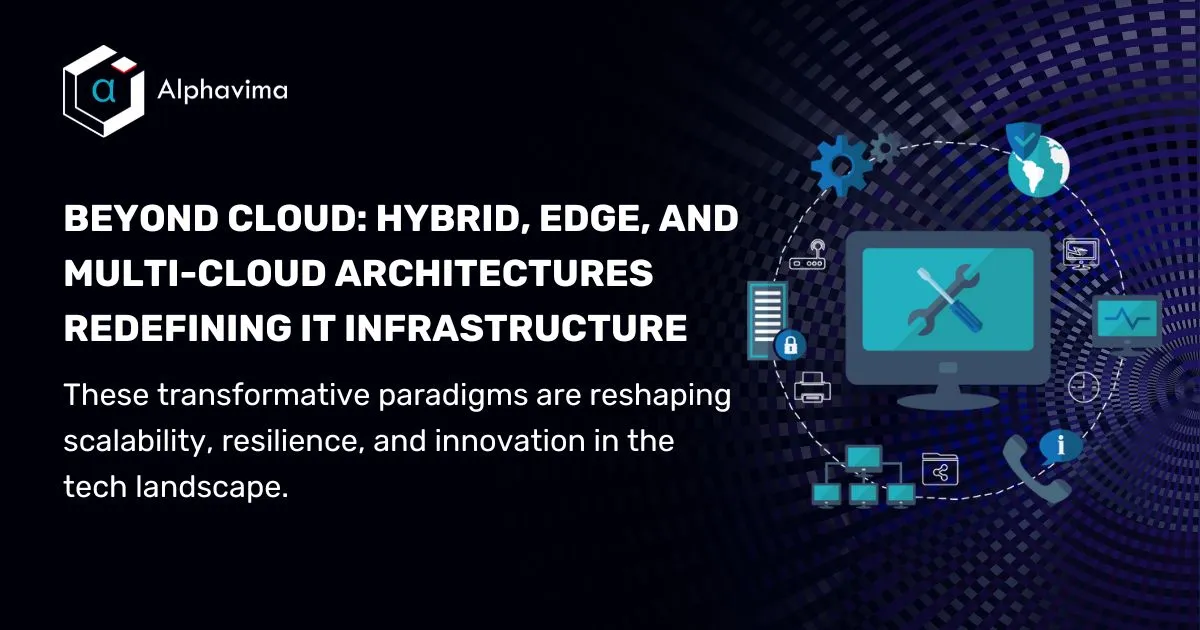Blog
Beyond Cloud: Hybrid, Edge, and Multi-Cloud Architectures Redefining IT Infrastructure
25 Jan 2024

In the contemporary realm of technological advancements, IT infrastructure has transcended conventional boundaries. The fusion of hybrid, edge, and multi-cloud architectures stands as a beacon of innovation, reshaping the landscape for CTOs, Directors, Leaders, and Managers in IT companies. This progressive paradigm shift challenges established norms, offering unparalleled flexibility, scalability, and resilience.
Evolution of IT Infrastructure
Tracing the Journey: From On-Premises to Cloud
The historical narrative of IT infrastructure unfolds from localized on-premises setups to the disruptive emergence of cloud computing. While traditional models offered scalability, they posed constraints that fueled the necessity for adaptable approaches, ushering in an era of dynamic and flexible solutions.
Hybrid Cloud: Unifying Diverse Environments
Definition and Characteristics
The historical narrative of IT infrastructure unfolds from localized on-premises setups to the disruptive emergence of cloud computing. While traditional models offered scalability, they posed constraints that fueled the necessity for adaptable approaches.
Advantages of Hybrid Cloud
- Flexibility and Scalability: Seamlessly scaling resources to meet dynamic demands while preserving critical on-premises assets ensures a balanced and responsive infrastructure.
- Enhanced Security and Compliance: Balancing sensitive data processing by maintaining critical information on-premises enhances security and regulatory compliance measures.
- Cost Optimization and Resource Utilization: Maximizing cost-effective cloud services while retaining essential applications in-house leads to efficient resource utilization.
Use Cases and Implementation Scenarios
Hybrid cloud’s utilization spans scenarios necessitating both cloud flexibility and on-premises control, such as sensitive data processing or robust disaster recovery plans, showcasing its versatility in meeting diverse organizational needs.
Edge Computing: Bringing Processing Closer
Understanding Edge Computing
Edge computing, propelling processing nearer to the data source, drastically reduces latency and augments real-time processing capabilities, revolutionizing the way data is handled and processed at the edge.
Benefits of Edge Computing
- Reduced Latency and Enhanced Performance: Imperative for applications demanding swift responses, especially in IoT devices, edge computing becomes a cornerstone for efficient and responsive systems.
- Bandwidth Optimization: Diminishing data transfers to central clouds optimizes bandwidth usage, providing a more streamlined and efficient data transmission process.
- Heightened Data Privacy and Compliance: Edge-based data processing fortifies privacy and ensures compliance adherence, addressing critical concerns in data governance.
Applications and Real-World Examples
Industries like IoT, healthcare, and retail have revolutionized operations through the localized decision-making prowess of edge computing, exemplifying its transformative impact across diverse sectors.
Multi-Cloud Strategies: Embracing Diversity and Redundancy
Concept and Characteristics of Multi-Cloud
Multi-cloud strategically harnesses multiple cloud service providers to mitigate risks and leverage specialized services, offering a resilient and diversified infrastructure.
Advantages and Challenges
- Increased Redundancy and Resilience: Curtailing reliance on a single provider amplifies system reliability, ensuring continuity in the face of disruptions.
- Avoiding Vendor Lock-in: Granting flexibility and preventing sole dependency on a vendor’s ecosystem promotes autonomy and strategic decision-making.
- Complex Management and Interoperability: Navigating the challenges of managing diverse infrastructures and ensuring seamless interoperability requires a strategic and well-thought-out approach.
Implementing Multi-Cloud Architectures
Strategies revolve around interoperability standards, workload management, and ensuring data portability, emphasizing the need for a comprehensive and adaptable implementation plan.
Impact on IT Infrastructure Management
1. Shifting Mindset: Adaptation and Governance
Adapting governance models to efficiently manage diverse infrastructure elements is a crucial paradigm shift, demanding a holistic and adaptable approach to governance.
2. Skill Set and Talent Requirements
The requisition of expertise in managing various cloud environments and ensuring seamless integration is imperative for IT teams, highlighting the importance of continuous skill development and training.
3. Tools and Technologies for Management
Automation, orchestration, and unified management platforms are pivotal for proficient infrastructure management, streamlining processes and enhancing overall efficiency.
Future Trends and Predictions
- Convergence of Architectures: The convergence of hybrid, edge, and multi-cloud architectures will blur the demarcation lines, creating a seamless and integrated IT landscape.
- Edge-to-Cloud Continuum: The seamless flow of data and processes between edge and cloud environments will become more pronounced and efficient, shaping a more interconnected and responsive ecosystem.
- Advancements in Security and Compliance: Continuous strides in security measures will accompany the evolution of these architectures, ensuring robust protection and compliance adherence in the ever-evolving digital landscape.
Conclusion
The transformation of IT infrastructure through hybrid, edge, and multi-cloud architectures signifies an era of unprecedented innovation. For Leaders in IT companies, embracing and leveraging these architectures is pivotal. By embracing these new approaches, organizations can reshape their IT infrastructure, guaranteeing adaptability, durability, and innovation in a constantly changing technological environment.
